30.04.2019
NASA weighing SLS Green Run versus EM-1 schedule risks
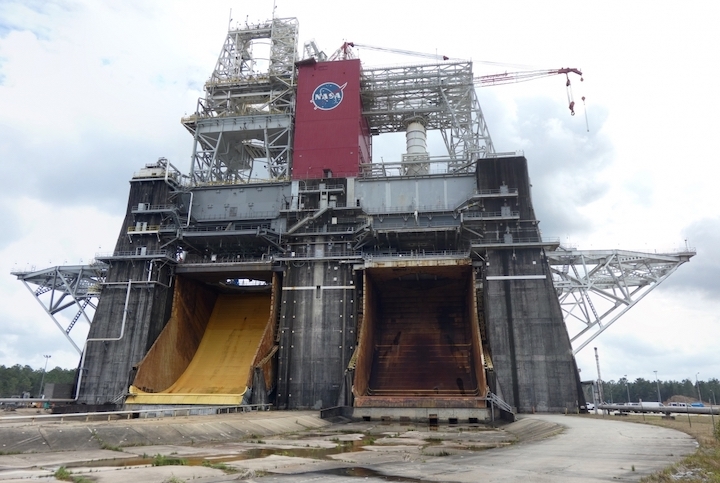
NASA is officially still deciding whether or not to take the time to conduct the big, integrated test of its Space Launch System (SLS) Core Stage. “This is why we test” is an oft-quoted philosophy in this phase of development of a new system; in order to keep hopes alive for a first launch within the 2020 calendar year, the agency revisited whether or not to continue to apply that philosophy to SLS.
Up until recently the “Green Run” or acceptance test of the stage was viewed as a critical development step in the program for the newest and most complicated part of the launch vehicle, but the test campaign is expected to take many months to complete and coupled with time lost during Core Stage assembly would likely to push launch of Exploration Mission-1 (EM-1) into 2021. The Stage Green Run would culminate in the one and only planned hot-fire test of a Core Stage before EM-1.
Delivery of the first Core Stage by prime contractor Boeing has been delayed several times, and NASA was hoping to both play catch up and speed up plans for a U.S. crewed lunar landing in 2024. The agency conducted a 45-day study that concluded in mid-April to again look for any means possible to recover some of the time lost and try to keep the EM-1 launch date target within 2020.
NASA is reportedly leaning towards keeping the test, which an outside safety panel strongly recommends, but a final decision has not been announced. Although the mission is uncrewed, it is crucial for SLS to fully deliver in its first launch on EM-1 because most of Orion’s lunar flight test objectives on its first solo flight depend on it.
Green Run is for the rookie stage, not the veteran engines
“Green Run” in this case is short for Core Stage Green Run and the test campaign is focused on testing the stage, not the engines. A Green Run is an acceptance test of new hardware and for liquid propulsion system testing at the Stennis Space Center in Mississippi the term can be applied to everything from acceptance testing new components to new engine builds to new rocket stages like the SLS Core Stage.
The Aerojet Rocketdyne RS-25 engines are one of the only Core Stage systems that are ready to fly today because they finished their testing a long time ago. The four flight engines (Engines 2045, 2056, 2058, and 2060) that will be installed in the first Core Stage have each demonstrated safe performance on multiple Space Shuttle launches when they were called Space Shuttle Main Engines (SSME).
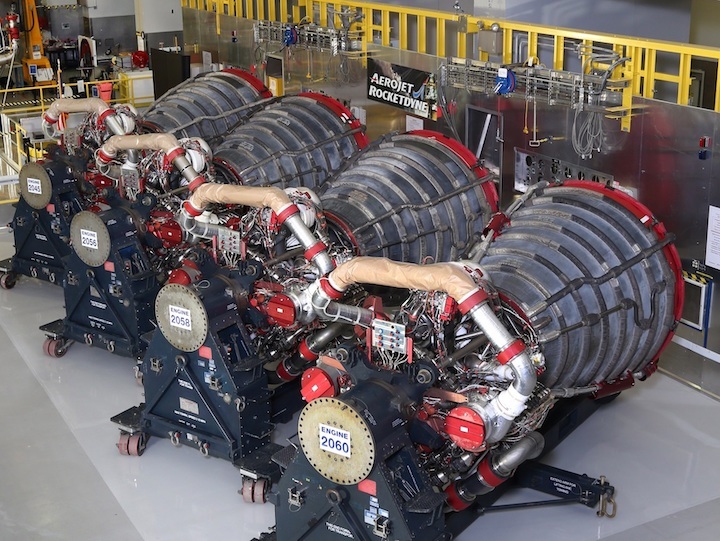
(Photo Caption: The four RS-25 flight engines assigned to EM-1 as “delivered in place” in October, 2017, at Aerojet Rocketdyne’s facility at Stennis.)
Two ground-only “development” engines (Engines 0525 and 0528) conducted numerous development tests that demonstrated the Shuttle design as adapted to SLS in both nominal and off-nominal conditions. Development hot-fire testing of the RS-25 “adaptation” configuration that will fly on the first four SLS launches concluded eighteen months ago.
Those single-engine tests from 2015 through 2017 qualified the Shuttle design to fly under SLS operating conditions, including their new engine controller units (ECU). The single engine testing in the A-1 stand at Stennis typically uses the development engines instead of flight hardware to test them out to the edges and corners of its operating envelope.
Using development engines avoids both general wear and tear on the flight engines from extra operating cycles and the additional demands of margin testing on the engine hardware; however, two RS-25 flight engines that didn’t fly during the Shuttle Program were standalone engine Green Run tests. Those acceptance tests further demonstrated the safe operation of RS-25 flight hardware to SLS requirements.
A third flight engine was fired during development testing in a calibration test of the A-1 stand.
In addition to the RS-25 engines, the SLS Boosters and the Interim Cryogenic Propulsion Stage (ICPS) upper stage also have an extensive ground test history, flight history, or both.

(Photo Caption: The SLS Core Stage and its elements. Although designed around the Space Shuttle Main Engines and using some other Shuttle Main Propulsion System (MPS) hardware, many of those components have either been modified or redesigned. The rest of the stage is new, including the arrangement of its systems.)
In contrast to the other elements of SLS that are flight-proven or ground-tested, the Core Stage is the new piece of the launch vehicle. It started development behind designs and hardware already evolved from Space Shuttle or the cancelled Constellation program and no working version has yet been tested.
When finally completed Core Stage-1 will not just be the first flight article, but also the program’s first working stage article. The Green Run of this first working unit is the only planned opportunity to demonstrate a full-duration test run of a Core Stage before the program’s first launch.
For the integrated hot-fire test, the RS-25 engines are essentially test support equipment to evaluate how well the new Core Stage meets the requirements to run four of them at the same time for more than eight minutes. In addition to meeting the demands of the engine cluster during mainstage, new SLS flight software will also be seeing its first full use.
The flight software running on the stage’s new flight computers is in charge of the overall control cycle of vehicle management, monitoring systems health, and commanding the stage through the Green Run test sequences via a brand new avionics system.
NASA and Boeing are qualifying the different Core Stage subsystems individually and testing some of them together in pairs and small groups, but the tests during the Stage Green Run will be the first time all stage systems are operated together.
Nothing official as ASAP makes recommendations
As a part of initiatives to shore up the EM-1 schedule, NASA began an internal 45-day study in early March looking for any other ways possible to shorten the schedule to launch readiness. Final assembly of Core Stage-1 is still the critical path, and a revised plan was recently put into effect to rearrange the order in which the three remaining pieces were attached and do both those mates horizontally.
The hope is that this will buy back a few months of schedule and stage assembly will be complete by the end of the year; however, by past scheduling that would still keep a launch before the end of 2020 in jeopardy. The 45-day study was looking for more schedule options and the Stage Green Run would stand out for anyone looking at content to cut.
The study was due on April 15 and after a review that week at NASA Headquarters in Washington, D.C., the SLS Program held an All-Hands meeting on April 22 where it was reported that the test was kept on the schedule. Ars Technica also reported on an internal memo NASA Human Exploration and Operations Directorate (HEOMD) Associate Administrator Bill Gerstenmaier sent the same day.
NASA says nothing has been decided yet. “A final review of the assessment is still underway and no decisions have been made,” NASA spokesperson Mike Curie wrote in an email following news of the All-Hands meeting.
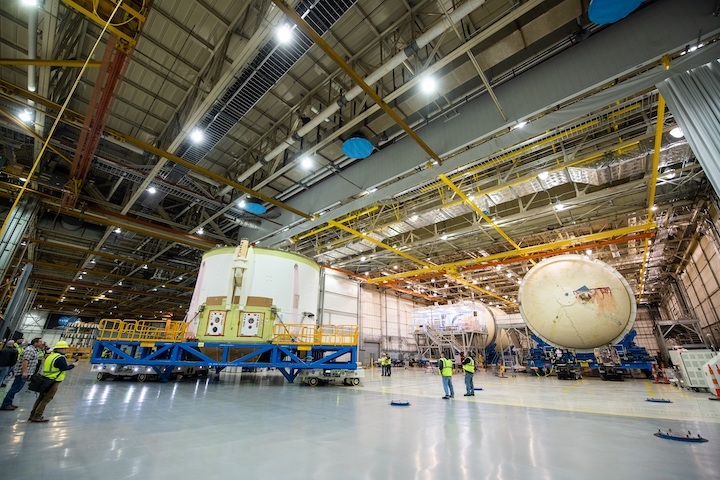
(Photo Caption: The mated Core Stage-1 engine section and boattail are driven into the Final Assembly area on a recently-furnished tool at the Michoud Assembly Facility (MAF) on April 1. Integration and checkout of the duo was moved into this area and the final assembly sequence was reworked to advance the completion date for whole stage, perhaps before the end of the year.)
The Aerospace Safety Advisory Panel (ASAP) emphasized their recommendation about the Green Run test in a public statement made on April 25 at the conclusion of their meeting at the Marshall Space Flight Center in Huntsville, Alabama. “There is no other test approach that will gather the critical, full-scale, integrated propulsion system operational data required to ensure safe operations,” Dr. Patricia Sanders, ASAP Chair, said during the public meeting.
“Shorter duration engine firings at the launch pad will not achieve an understanding of the operational margins and could result in severe consequences if conducted in a much less controlled environment than Stennis and if the margins are exceeded. I cannot emphasize more strongly that we advise NASA to retain this test.”
The Core Stage production schedule has been a critical path concern for a long time and there were reports as far back as early Summer 2018 of studies to look at substituting a brief Flight Readiness Firing (FRF)/static fire on Launch Pad 39B at the Kennedy Space Center instead of the Green Run in hopes of getting back some of the time lost. Although static fire tests at the launch site have often been run before the first flight of a new program or a new vehicle, typically those were preceded by more thorough acceptance tests.
The Space Shuttle Program ran twenty-second long FRFs on new Orbiter Vehicles prior to their first flight, but not before putting a Main Propulsion Test Article (MPTA) through several ground test-firings in the late 1970s and early 1980s in the B-2 test stand. SpaceX still performs flight-duration acceptance tests of stages in Texas before the pre-launch first stage static fire on their launch pads in Florida.
The Delta 4 program used the same Stennis B-2 stand to hot-fire a Common Booster Core (CBC) first stage prior to both the program’s first launch and a pre-launch FRF. The Saturn program also performed flight-duration acceptance test firings of their stages at sites around the country in the 1960s, including what is now called the Stennis Space Center.
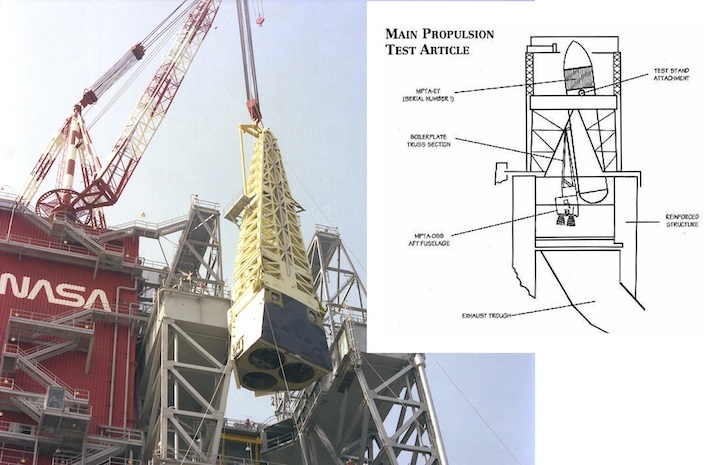
Photo Caption: The Space Shuttle Main Propulsion Test Article was used to conduct long-duration, integrated propulsion system test firings at Stennis. The left image shows the orbiter aft fuselage built and integrated for the MPTA being lifted into the B-2 Stand in 1977. The aft fuselage, analogous to the SLS Core Stage engine section, was mated with a truss structure so it could be attached to a Shuttle External Tank. The figure on the right shows the integrated MPTA test configuration; for SLS these same basic elements were merged into a bigger, inline design.)
An FRF on the pad at KSC would be limited. The water supply for sound suppression and deluge of the flame trench and launch platform at KSC is designed and sized for the vehicle to liftoff and clear the area relatively quickly. It will run out after only seconds of engine run time.
As with Shuttle, SLS doesn’t throttle up to full power until after liftoff; whereas the Stennis test plan is to throttle the engines up to 109 percent of rated power level (RPL) and try to replicate a flight-like throttle profile, it’s unclear if KSC can support full power during a hypothetical FRF.
During the ASAP’s April 25 public meeting to summarize their private discussions with NASA earlier in the week, Dr. Sandra Magnus may have alluded further to the “understanding of the operational margins” that Dr. Sanders stated in her opening remarks.
In a summary of ASAP’s review of the status of NASA’s Commercial Crew Program (CCP), Dr. Magnus, a former Shuttle astronaut who flew on the program’s final flight, noted that prior to committing to crewed flights CCP requires enough test data “to ensure that we understand the margins, that we are controlling those margins, and that we’re operating in the environment that those margins require.”
Only planned pre-launch integrated Stage test
Boeing and NASA have analytical models for the different fluid and structural dynamics of the stage; the full-duration, integrated stage ground test would provide data to compare to the model’s predicted performance. “I think that most of it is to get the data to validate the models, to anchor those and then go back and re-run them with the actual test data,” Marc Neely, NASA Core Stage Green Run Test Operations and Execution Manager, said about the Stage Green Run campaign in a March interview at Marshall.
“A lot of the objectives are demonstration objectives of systems that haven’t been operated together,” he added. In the interview, which was done prior to the announcement that skipping the test was being considered, Neely also noted the acceptance test nature of a Green Run.
“It’s not a development test series, where you bring a new stage, a new test article out there and run it on all the corners of the [operational parameter] boxes and see what it’ll do and see what it won’t do and then go make changes,” he added. “This is more in the vein of an acceptance test.”
Decades of Space Shuttle flights and ground testing have established the interface requirements for the engines. For the Core Stage, its Main Propulsion System (MPS) has to provide those interfaces, as adapted for the SLS operating environment and its performance requirements.
The stage also has four RS-25 engines versus the three in the Shuttle Orbiter. They will start and run at higher pressures than Shuttle and their hydrolox propellant will be fed to them during that time at lower temperatures.
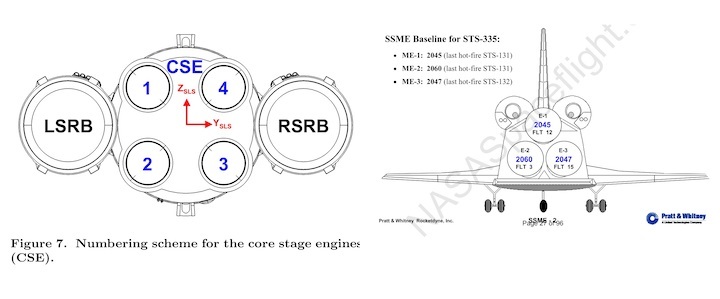
Photo Caption: The SSME/RS-25 configurations for SLS on the left and the Space Shuttle on the right. The engines, MPS, and rocket avionics were carried inside Shuttle Orbiters separate from the propellant tanks, which allowed them to be reused. Those components were merged with the External Tank elements and expanded in the inline configuration of the expendable SLS Core Stage. SLS flies with four engines instead of three and the propellant tanks in the stage are significantly longer.)
The RS-25 has already demonstrated its operating margins and control at the engine level, with the single-engine test stand replicating SLS operating environment input parameters (propellant temperatures, pressures, flow rates). Qualification testing of the individual stage subsystems like hydraulics/thrust vector conrol (TVC), avionics, and software are being performed by the program before the integrated Stage Green Run, but the hot-fire test of the integrated stage provides the opportunity to demonstrate that all of the components in the stage can perform together.
The hot-fire test at Stennis would provide data to validate that the stage can deliver all the services required by the engines when they are firing at their commanded thrust levels, and that when combining all of those different subsystems and their interactions, everything continues to behave within their predicted ranges.
The new SLS software would conduct the automated firing and collect the data from the new Core Stage avionics, but can shut everything down if something strays outside its critical redline parameters. The closer to the middle or center of their predicted ranges, the greater the operating margins for all the integrated stage elements, including for the engines.
Integrated propulsion system
MPS consists of the feed systems for both propellant tanks, liquid oxygen (LOX) and liquid hydrogen (LH2), the hydraulic/TVC system, pneumatics provided by gaseous helium, and a pressurization system for the tanks.
While the propellant has to be fed by the MPS to the engines at the right temperatures, pressures, and flow rates, the hydraulic systems provide the power to the TVC actuators to control the position of all four engines, and for operation of the RS-25 engines themselves. Valves in the engines are hydraulically actuated to get them started, adjust power levels, and shut them down.
The MPS pressurization system maintains the structural integrity of the propellant tanks; as the engines drain propellant from the tanks, they must be kept pressurized. “You want to make sure that your pressurization system in an actual hot-fire where the tanks are draining can keep up with that amount of mass exiting the tank,” Neely explained. “If you don’t keep [the ullage] filled, the tank will collapse.”
The MPS systems work together and in some cases are interdependent. As with the Shuttle MPS, gaseous hydrogen (GH2) and oxygen (GOX) are tapped from all the running engines and routed up to the top of the propellant tanks to maintain ullage pressure within limits. Unlike Shuttle, SLS is also using that GH2 tap-off to drive all four hydraulic systems in flight.
“You have the CAPU (Core Auxiliary Power Unit) that provides the hydraulic power to the TVC actuators,” Neely said. “They’re turbine-driven hydraulic pumps and the turbine power is supplied by [ground] helium until the engines start, and then the hydrogen tank repress comes off the engine, so it’ll tap that off and use some of that to power these turbines to provide the hydraulic power.”
“Well the engines and the CAPUs have never been run together and they’ve never been run in a stage environment, so [Green Run] is a demonstration of that. Of course they’ll be taking data, looking at the flow rates and the hydraulic pump performance.”
“A lot of that is heritage hardware, Shuttle hardware, that CAPU system, so there shouldn’t be a whole lot of unknown in terms of the pump efficiency or the performance, but that’s the sort of thing they’ll look at,” he added.

(Photo Caption: The two tank repressurization lines exiting the Core Stage-1 engine section are highlighted in the closeup inset. The pair of lines, just to the right of the foam-covered LOX downcomer on the -Z side of the stage, will carry pressurization gas from the engine section to the top of both propellant tanks.)
A long stage firing would not only provide more data on the operational interaction of the MPS systems, but also on those interactive dynamics during steady state operations and in response to engine throttling and gimbaling. During the last minute or so of powered flight, the engines will be throttled down to stay within acceleration limits and the throttle profile for the Green Run will simulate this as much as possible while the engines fire close to sea level.
This period at the end of the firing will provide a window of opportunity see how the stage performs with the engines throttled down and the propellant tanks getting close to empty. “There may be some data that they need for model validation at those lower engine power levels, their feedline models or their tank press models, because that’s coming off the engines,” Neely noted.
Finally, the pneumatic system is used to actuate the MPS valves, all the components that help fill the propellant tanks and then feed the engines during launch and ascent. Five large composite overwrapped pressure vessels (COPV) in the engine section store the gaseous helium used by the pneumatic system.
The helium is also a critical need for the engines to purge different areas during mainstage. “One essential function…is the purging of the high-pressure oxidizer turbopump’s intermediate seal cavity,” NASA’s Space Shuttle Reference Manual noted.
“This cavity is between two seals, one of which contains the hot, fuel-rich gas in the oxidizer turbine. The other seal contains the liquid oxygen in the oxidizer turbopump.”
“Leakage through one or both of the seals and mixing of the propellants could result in a catastrophic explosion,” the manual adds. “Continuous overload purging of this area prevents the propellants from mixing as they are dumped overboard through drain lines.”
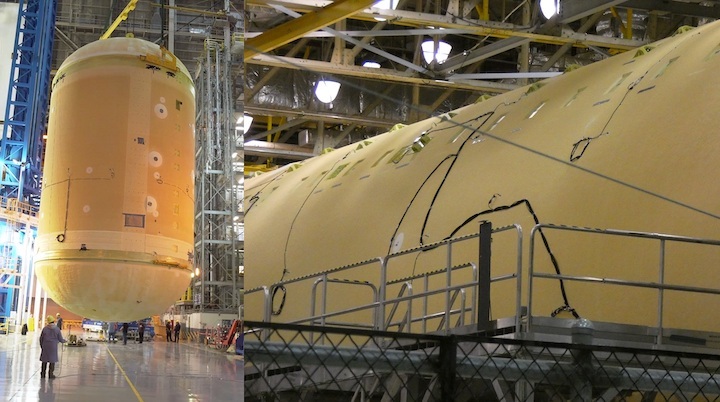
Photo Caption: The wire harnesses for Green Run test instrumentation are seen on the outside of both Core Stage-1 propellant tanks. On the left, the wiring connects a circle of accelerometers embedded into the surface of the LOX tank foam. On the right, similar wiring and ground test instrumentation can be seen on the LH2 tank. A series of clips are also embedded into the foam on the tanks to secure the wiring runs for activities up to and including the Green Run. The test-specific clips and sensors will be removed prior to launch.)
A full-duration firing will demonstrate that the stage’s pneumatic system keeps up with the helium demands of all four engines for the length of a powered flight while also maintaining service to its other MPS customers. Helium also provides an alternate way to close the engine valves to pneumatically shutdown an RS-25 in a contingency case where a running engine has gone into hydraulic lockup.
Core Stage-1 is partially assembled at its Michoud Assembly Facility production site in New Orleans, but it is already outfitted inside and outside with ground test instrumentation for the Green Run in addition to its operational and development flight instrumentation. Accelerometers are bonded into the surface of the spray-on foam insulation (SOFI) on the outside of the propellant tanks and cameras would be installed inside the intertank for Stennis testing.
The instrumentation is to be used during the hot-fire test to collect frequency response data from the stage while the engines were firing. Another window of time a few minutes into the stage hot-fire test was set up to gimbal opposing engines to create the desired test conditions. The cameras will also capture video of how different propulsion system hardware elements perform during first-time propellant loading and stage firing operations.
Schedule risks from EM-1 not just with pre-launch delays but with in-flight performance
There is schedule risk in keeping the Green Run test campaign, but there is also risk in skipping it. Even a flight-duration ground test like the Stage Green Run can only go so far with the vehicle firmly held in place in a test stand; launch and ascent will still be the first full test of the new launch vehicle, with elements such as Guidance Navigation and Control (GNC) that can’t be fully tested until the vehicle is in motion.
If the EM-1 launch schedule moves into 2021, it could begin to again impact preparations for the Exploration Mission-2 (EM-2) flight tentatively scheduled for 2022 which will be the first crewed Orion mission. The EM-2 Orion spacecraft is going through its assembly and integration work in Florida and Germany; the current plan is for the EM-2 Crew Module to reuse some of the EM-1 spacecraft’s avionics on return and those could once again become pacing items in the integration schedule depending on when EM-1 flies.
The Orion program already started the process to decouple the EM-1 and EM-2 spacecraft schedules by bringing forward production of a second set of core avionics boxes; however, the remaining ones will need to be removed from the EM-1 spacecraft after splashdown and refurbished before they can be installed in the EM-2 spacecraft.
On the other hand, the schedule for a 2024 lunar landing mission is at stake not just by how long SLS development and testing takes before EM-1, but by how well the SLS vehicle performs in its first flight. The schedule risk from keeping the Green Run test campaign on the schedule may be greater than a complete or partial loss of the mission in flight, but the difference is arguable and neither risk is insignificant.
If it turns out that the one or more of the Core Stage propulsion, mechanical, or computer systems operate outside of their predicted margins the first time they are run together for an extended period of time, learning that lesson in flight instead of on the ground at Stennis could carry its own schedule risks.
EM-1 is as critical a test flight for Orion as it is for SLS. Orion relies on something close to a full delivery from this first SLS launch, with many of the flight test objectives depending on the spacecraft traveling all the way to the Moon and back. The spacecraft can’t really start its mission until SLS finishes its work.
Something less than a full-duration Core Stage firing that even safely leaves Orion short of the Moon on EM-1 jeopardizes the downstream schedule. An EM-1 mission that is aborted right out of the proverbial gate could cause significant schedule disruptions if it has to be reflown, requiring another spacecraft and another booster to be assembled to accomplish EM-1 objectives.
Although EM-1 is an uncrewed mission, the number of Orion spacecraft available to fly between now and the Trump Administration’s goal to land U.S. astronauts on the Moon again by 2024 is limited. Including the EM-1 spacecraft there may be only three units produced in that time, making mission success for every flight critical.
Both the Orion and SLS programs are working towards a production rate of one spacecraft and launcher per year, respectively but haven’t yet reached those goals. With these long-known factors, the EM-1 flight test objectives are critical to both EM-2 and EM-3.
With the EM-2 mission planned as the first with crew, its current objectives are more conservative and incremental, with plans to return after performing a lunar free-return/flyby. That would mean that the EM-3 Orion spacecraft may be the one that shuttles the 2024 lunar landing crew to the cislunar Gateway, where some or all of the crew would transfer to a to-be-developed and constructed landing spacecraft.
If EM-3 is the crew transport mission for the 2024 lunar landing goal, some parts of the EM-1 flight test plan could provide the only opportunity to demonstrate operations that EM-3 and its crew will rely on. EM-3 will also be the first planned rendezvous and docking for Orion.
NASA recently decided not to pull the EM-1 mission off SLS and put it on a domestic commercial launcher in part to preserve the full set of flight test objectives.
Quelle: NS
----
Update: 14.05.2019
.
NASA EGS Launch Team begins EM-1 countdown simulations

The Exploration Ground Systems (EGS) team that will launch the first integrated Orion and Space Launch System (SLS) vehicle started formal countdown simulations last month in the Launch Control Center (LCC) at the Kennedy Space Center (KSC) in Florida. The first “run for record” simulation covered different blocks of work in the period of the countdown around cryogenic loading operations of the launch vehicle.
The launch team is practicing with their ground control equipment against emulators that simulate the behavior of flight and ground equipment, and the simulations help demonstrate the capacity of all the different specialties within the team to handle issues to keep a countdown progressing towards liftoff.
